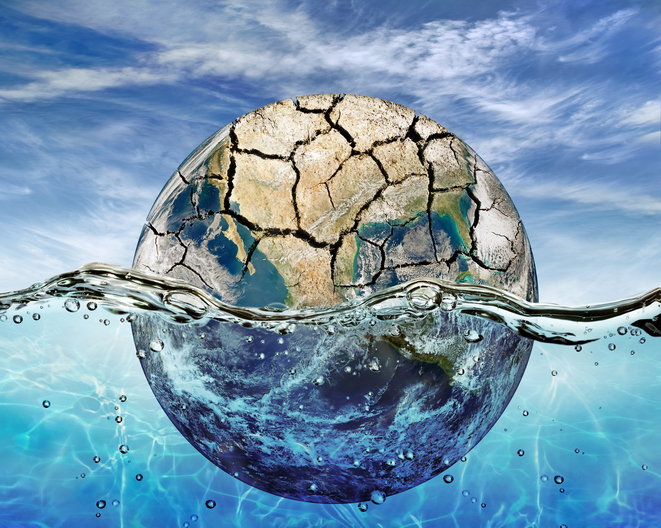How Water Policies Fails to Address the Needs of Women

Lonely plant in the parched earth submerged in the ocean Some graphics in this image is provided by NASA and can be found at http:/photojournal.jpl.nasa.gov/catalog/PIA18033; To create a file was the program used Photoshop CS5. The image created by 31.08.2013

The Goa government has launched the “Save water to Get Free Water” program, making it the first state to provide free water to its citizens. Under this policy, households are not billed for consumption up to 16,000 litres. Odisha’s Puri became the first city with a “Drink from Tap Facility”. Water initiatives in the country are rolling fast and furious, increasing the physical and psychological well-being of the citizens.
While all these initiatives are encouraging, the water sector can largely be blamed for gender blindness. The National Water Policies (1987, 2002, 2012) did not take into account the special needs, problems, worries and realities of women as a specific group. Even if the community has improved access to this vital resource, women’s access and control over it remain severely limited.
Women share a deep relationship with water. Water is just as supportive, nourishing and nurturing for life as the women themselves, in their role as domestic servants and also in their contribution spaces such as fishing, agriculture, clothing industry, food processing plants, etc. Women are the largest users of water, therefore, it is not new to see women walking miles to get just one bucket of water in drought-prone areas balancing earthen pots over their heads in rural areas, which is not without consequences.
The workload increases disproportionately both in terms of intensity and time expenditure. Empirical evidence suggests that women spend 382 minutes a day at home and men only 51.8 minutes, leaving women with very little time for other activities and productive roles, such as attending school or learning a skill that can open up opportunities for existence or even take on entrepreneurial roles. Their free time is also greatly reduced. In addition, the physical and psychological vulnerability of women increases due to heat, exhaustion, stress and the increased likelihood of sexual assault on long, lonely walks to water resources. Therefore, women as a group are disproportionately affected by the unavailability of water resources and the lack of access or control over available water sources.
The National Water Policies did not take into account the unique positions of women, their vulnerabilities and realities, but rather articulated the concerns of women as members of a “household” since the household is the accepted unit of action in politics. The position of women in accordance with water resources has been pre-assumed by a large group of people which ensemble contributes to their invisibility.
In addition, women are also being overlooked as important administrators of these resources. The empirical evidence shows that women are excellent at distributing and managing this resource, dividing it between arable land, main arable land, livestock and the domestic environment. In fact, in times of scarcity, women are more efficient managers of this resource and can use it sparingly and carefully. In addition, indigenous knowledge that women have in predicting availability, reliability and quality is rejected as “ad hoc” and “unscientific”.
Policies assign water rights as a part of land rights and leave women and the poor out of the scope. Women have poor access to and control over land, and so are their possessions, access and control over water resources. Regulating water for irrigation, household use and other areas also link water rights with property rights. Women have few property rights and their control is severely limited, as is their control and better access to water.
Unfortunately, women’s presence in the planning, provision and management of water resources at all levels is absent. Most of the water user associations (WUAs) are dominated by men and the proportion of women is too low to change the effect. Community resources of water are also controlled by men. Even their locations are limited by men. And all this is when women are the one who is actually more engaged with this resource.
Every water initiative seeks to improve people’s lives by improving access to good quality water. This is also the aim of the National Water Policies through the planning and development of new water resources and their optimal use. However, by ignoring the specific needs of women, politics has overlooked the essential connection women have with water. Their experience- collective as well as personal- has not been reflected in political initiatives. Long queues are still common, women still go long distances for the coveted pot of water, they continue to languish under the pressure of the household burden, which includes the procurement of water and making it available for domestic participants. The gender blindness and biases of these initiatives keep women in marginalized and unproductive roles.
The Goa government’s plan is remarkable, but the loudest applause will be reserved for those initiatives that bring the reality of women to the limelight.
The National Water Policies did not take into account the unique positions of women, their vulnerabilities and realities, but rather articulated the concerns of women as members of a “household” since the household is the accepted unit of action in politics. The position of women in accordance with water resources has been pre-assumed by a large group of people which ensemble contributes to their invisibility.

The Goa government has launched the “Save Water to Get Free Water” program, making it the first state to provide free water to its citizens. Under this policy, households are not billed for consumption up to 16,000 litres. Odisha’s Puri became the first city with a “Drink from Tap Facility”. Water initiatives in the country are rolling fast and furious, increasing the physical and psychological well-being of the citizens.
While all these initiatives are encouraging, the water sector can largely be blamed for gender blindness. The National Water Policies (1987, 2002, 2012) did not take into account the special needs, problems, worries and realities of women as a specific group. Even if the community has improved access to this vital resource, women’s access and control over it remain severely limited.
Women share a deep relationship with water. Water is just as supportive, nourishing and nurturing for life as the women themselves, in their role as domestic servants and also in their contribution spaces such as fishing, agriculture, clothing industry, food processing plants, etc. Women are the largest users of water, therefore, it is not new to see women walking miles to get just one bucket of water in drought-prone areas balancing earthen pots over their heads in rural areas, which is not without consequences.
The workload increases disproportionately both in terms of intensity and time expenditure. Empirical evidence suggests that women spend 382 minutes a day at home and men only 51.8 minutes, leaving women with very little time for other activities and productive roles, such as attending school or learning a skill that can open up opportunities for existence or even take on entrepreneurial roles. Their free time is also greatly reduced. In addition, the physical and psychological vulnerability of women increases due to heat, exhaustion, stress and the increased likelihood of sexual assault on long, lonely walks to water resources. Therefore, women as a group are disproportionately affected by the unavailability of water resources and the lack of access or control over available water sources.
The National Water Policies did not take into account the unique positions of women, their vulnerabilities and realities, but rather articulated the concerns of women as members of a “household” since the household is the accepted unit of action in politics. The position of women in accordance with water resources has been pre-assumed by a large group of people which ensemble contributes to their invisibility.
In addition, women are also being overlooked as important administrators of these resources. The empirical evidence shows that women are excellent at distributing and managing this resource, dividing it between arable land, main arable land, livestock and the domestic environment. In fact, in times of scarcity, women are more efficient managers of this resource and can use it sparingly and carefully. In addition, indigenous knowledge that women have in predicting availability, reliability and quality is rejected as “ad hoc” and “unscientific”.
Policies assign water rights as a part of land rights and leave women and the poor out of the scope. Women have poor access to and control over land, and so are their possessions, access and control over water resources. Regulating water for irrigation, household use and other areas also link water rights with property rights. Women have few property rights and their control is severely limited, as is their control and better access to water.
Unfortunately, women’s presence in the planning, provision and management of water resources at all levels is absent. Most of the water user associations (WUAs) are dominated by men and the proportion of women is too low to change the effect. Community resources of water are also controlled by men. Even their locations are limited by men. And all this is when women are the one who is actually more engaged with this resource.
Every water initiative seeks to improve people’s lives by improving access to good quality water. This is also the aim of the National Water Policies through the planning and development of new water resources and their optimal use. However, by ignoring the specific needs of women, politics has overlooked the essential connection women have with water. Their experience- collective as well as personal- has not been reflected in political initiatives. Long queues are still common, women still go long distances for the coveted pot of water, they continue to languish under the pressure of the household burden, which includes the procurement of water and making it available for domestic participants. The gender blindness and biases of these initiatives keep women in marginalized and unproductive roles.
The Goa government’s plan is remarkable, but the loudest applause will be reserved for those initiatives that bring the reality of women to the limelight.

Masters in Political Science IGNOU








